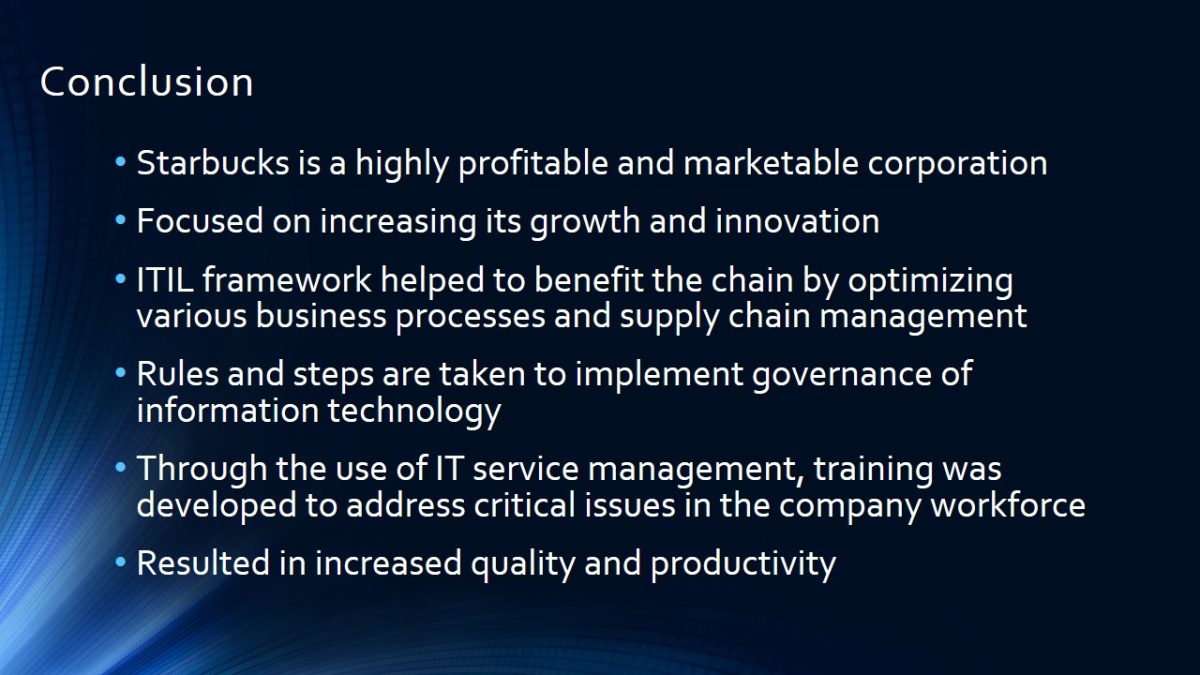Introduction
- Starbucks a multi-billion-dollar coffee company.
- Net revenues a record $6 billion.
- Innovative and profitable business model.
- Does not rely heavily on a franchise model.
- Wants to maintain control over quality and workplace culture in its stores.
Starbucks has been increasingly successful in its market segment due to its innovative practices. It operates an international chain of coffeehouses that offers a variety of food products. Furthermore, it has created a coffee brand which is sold in grocery stores. The brand revolves around creating an atmosphere in its stores and its excellent quality of services delivered by frontline staff. Although company-owned restaurants result in higher operating expenses, Starbucks wants to maintain greater control. The staff should comprehend and practice the company’s culture and vision. The company believes that the only way to manage that is through company-owned stores.
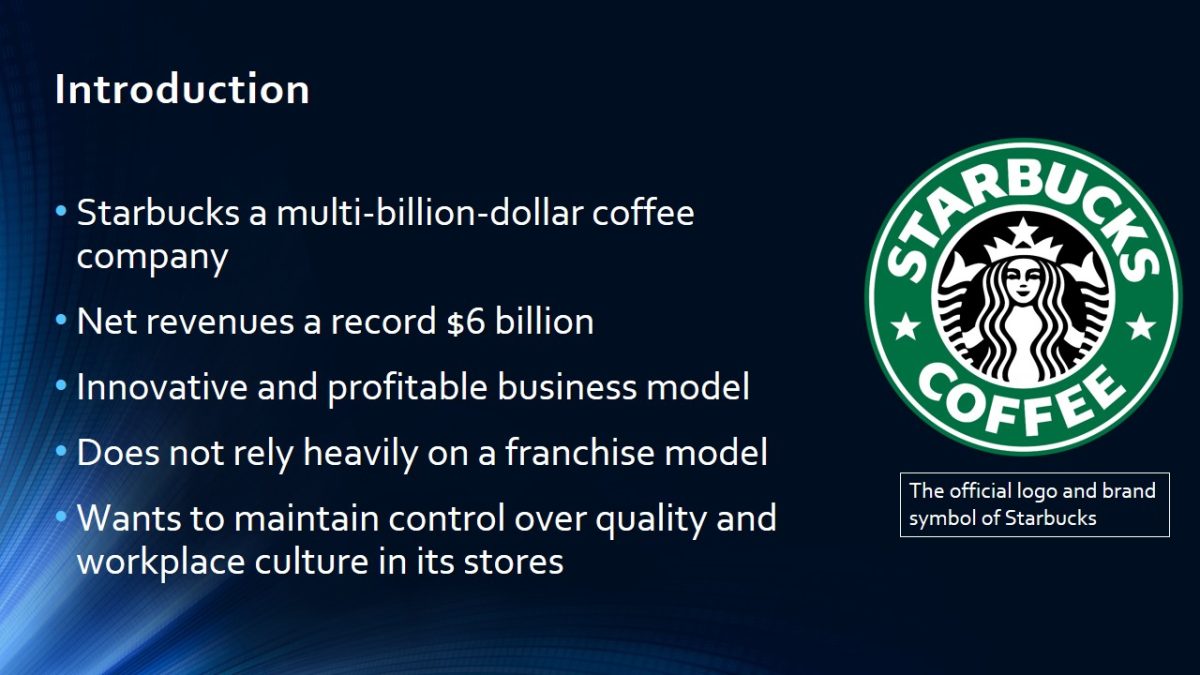
Problems at Starbucks
- The corporation sought to respond to market competition.
- To increase satisfaction margin, training was introduced for its staff.
- However, Starbucks struggled to find an adequate training supplier.
- Training curriculums were purchased from multiple suppliers.
- As a result, the company staff was experiencing fragmentation and lacked critical skills to provide the perfect customer experience.
The issue that Starbucks continued facing is a lack an adequate training system for its staff. This resulted in an undertrained and fragmented workforce, which reflected on the quality of offered products and services. Over 30 different suppliers initially offered a training course for the company. This was time-consuming due to the proliferation of certificates. Furthermore, it lacked quality or any value for the company’s business model.
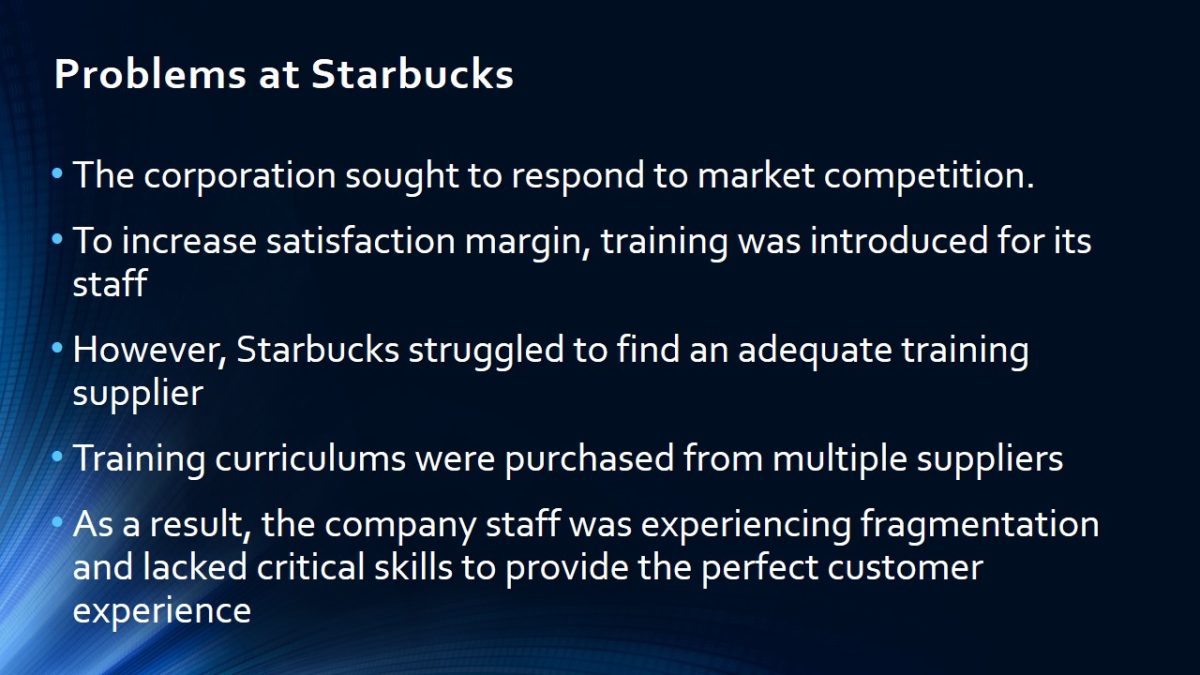
Adopted Framework
- Starbucks adopted the framework known as Information Technology Infrastructure Library (ITIL).
- A set of practices to enhance delivery of IT services to meet business demands.
- Increased quality of products and quantity of sales.
- Optimized and coordinated the supply chain management processes.
- Evaluation of IT service performance to enhance asset utilization.
ITIL is a list of various processes, tasks, and procedures which can be implemented to any business model to optimize processes within the company. It helps with integration and implementation of business strategy and delivering value. ITIL helped Starbucks significantly by optimizing its supply chain, improving quality of products, and reducing costs. There was a coordinated effort to implement the most efficient business practices and investment in critical segments of the company, including information technology.
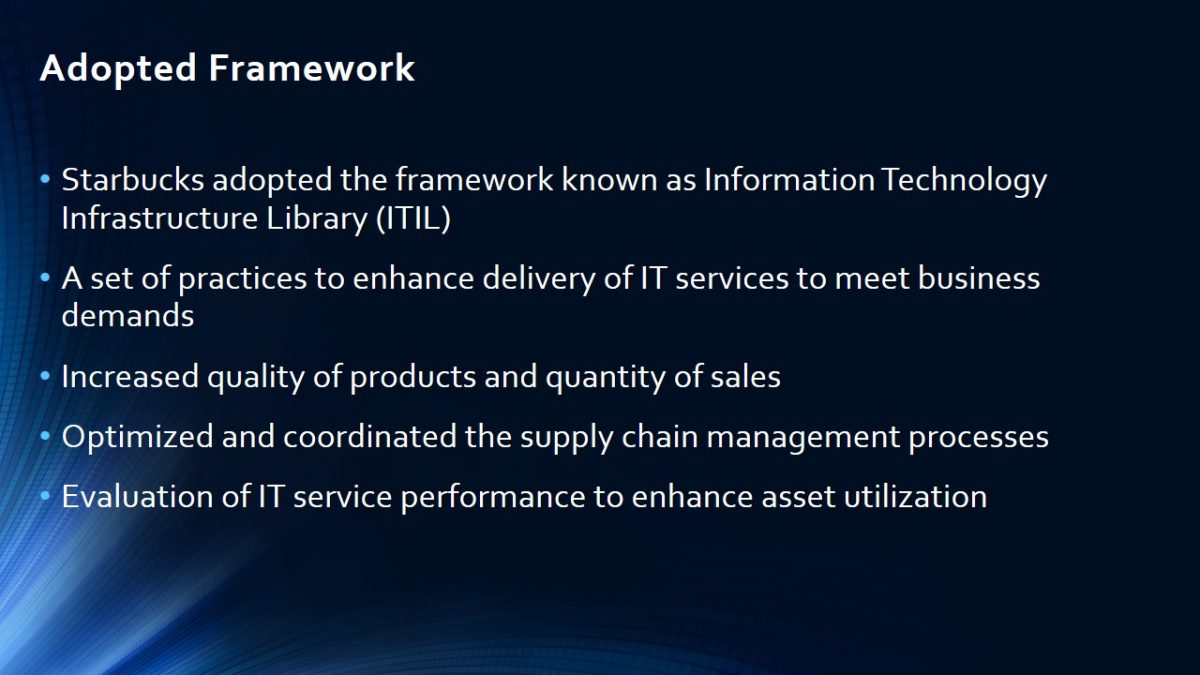
Basic Aspects of the ITIL framework
This diagram presents the basic outline for the ITIL framework. ITIL is essentially a volume set of books which seeks to accommodate and describe the best practices in information technology and IT service management. As demonstrated by the diagram, ITIL covers various stages of an IT service lifecycle from strategy development to evaluation and improvement. ITIL includes aspects such as service support and delivery, implementing service management and infrastructure support. Furthermore, it offers insight into applications, security, and business management. The initial purpose of ITIL was not creating a commercial service but rather as an information database. The framework is recognized for its effectiveness and credibility. It is currently owned by a company called Axelos which licenses it out.
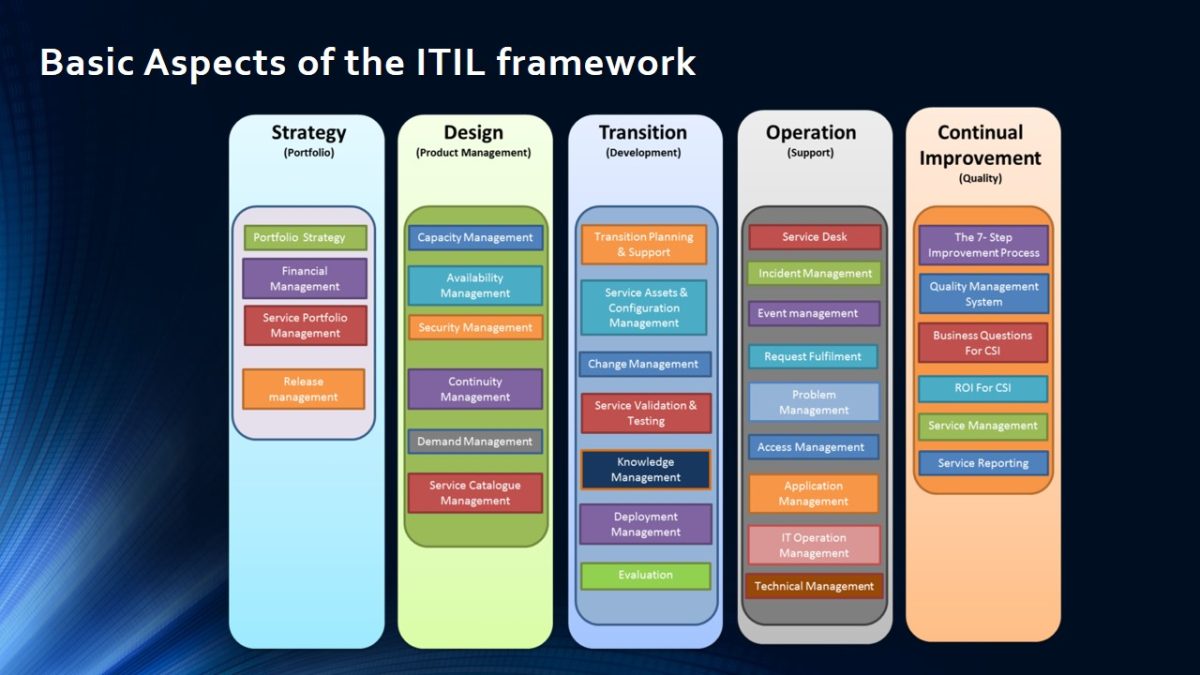
ITIL Benefits
- Optimization of IT services and company’s resource utilization.
- Reliability and security of critical IT infrastructure.
- Time-saving by decreasing redundant processes and reworks.
- Market competitiveness.
- Improved project delivery, both in time and quality.
- Integration and centralization of operational processes.
In a modern economy, information technology has become a critical part of any company’s function and growth. Business profitability is reliant on the performance and dependability of IT services. ITIL helps to mitigate any IT-related issues. Furthermore, it serves as an exception tool to apply in-company process improvement and optimization without the need to outsource technology services. Businesses can more efficiently manage IT costs and assets while achieving desired outcomes through improved service delivery and customer satisfaction.
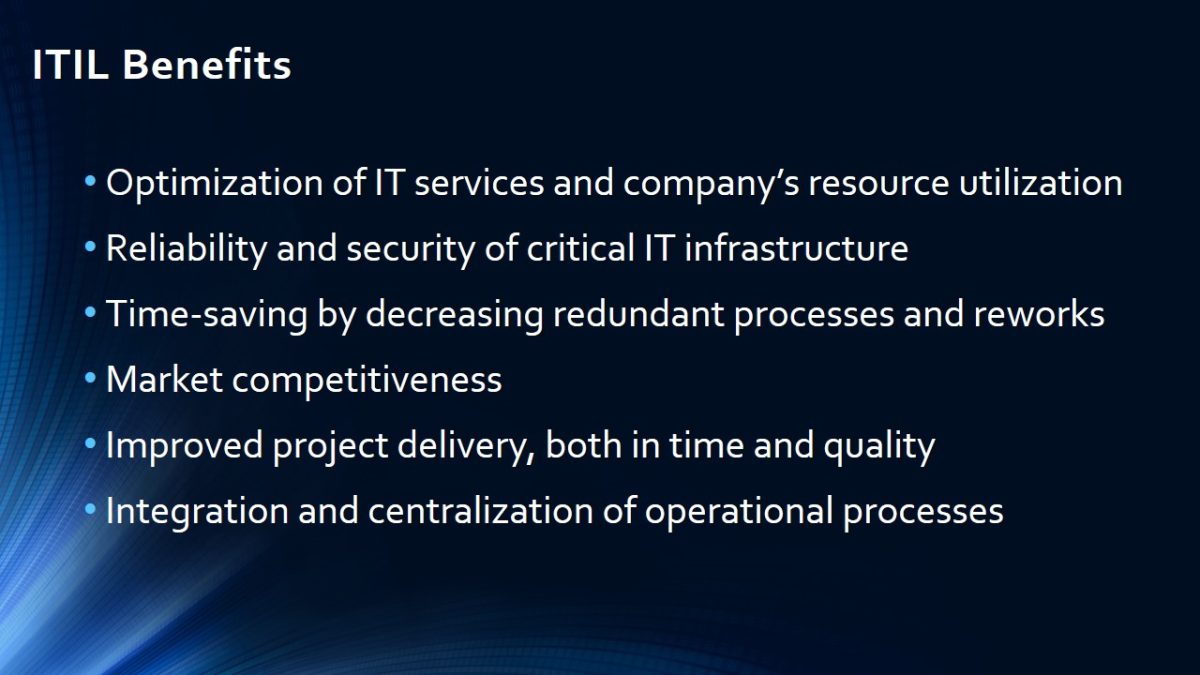
Steps to Implementing ITIL
- The company assessed which segments of the business benefited from the framework.
- Financial reports and benchmarks were used to evaluate operational processes.
- New and improved objectives were set to align existing company processes with its goals for the future.
- ITIL was implemented using business consultants and the project management methodology.
- The impact of ITIL implementation was evaluated based on performance outcomes.
ITIL is implemented through a series of steps that seeks to determine, evaluate, and fix any issues within an organization. It is a complex process which requires in-depth analysis of the organization and then setting goals to align the company’s vision with set objectives. Only then is IT service management implemented to begin introducing changes to operational scripts, procedures, and management tools. In the end, the whole aspect must be evaluated as well to determine the efficiency of the ITIL system in addressing organizational problems.
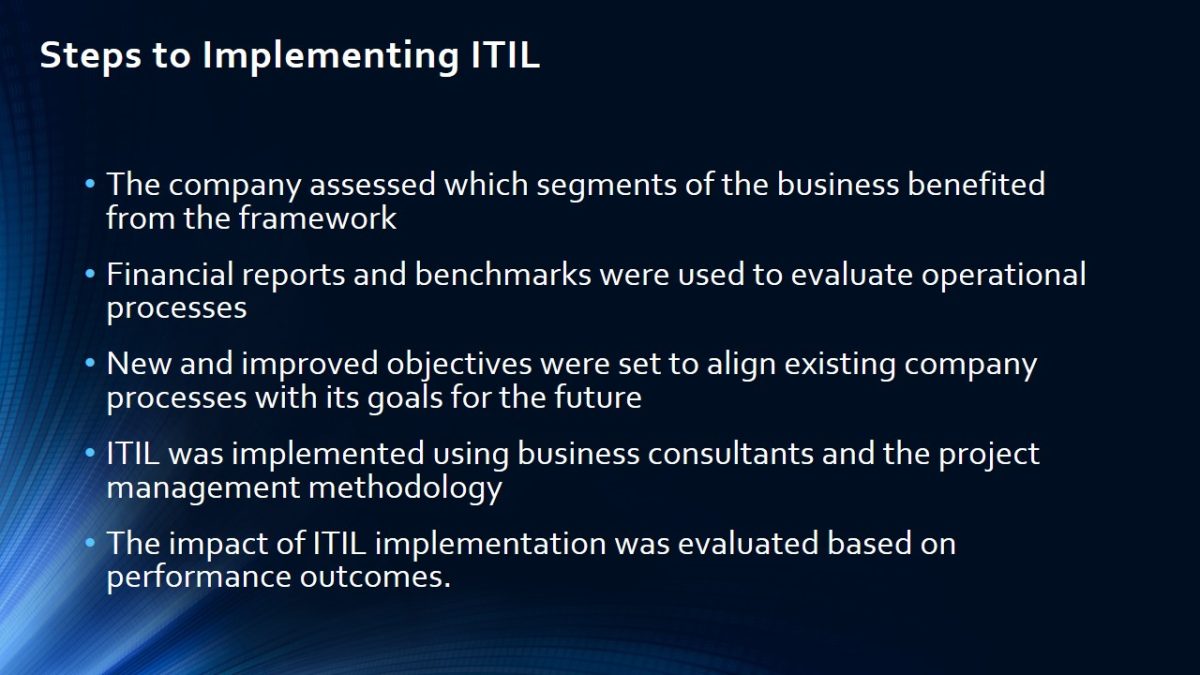
Adapting IT Service Management to Business
- ITSM is central to finding solutions to problems and creating profit.
- Many ITSM structures are unable to manage the data volumes.
- Business growth requires maturation of IT service delivery model.
- ITSM should maintain flexibility and productivity.
- Social computing is the future of IT service management.
It is inherently difficult to devise an ITSM strategy for modern businesses due to a large number of influencing factors and indicators for tracking. Furthermore, the growth of cloud computing, mobile use, and social networking is creating vast amounts of data which IT infrastructure must manage and use for business analytics purposes. This is where many companies fail with their IT infrastructure and operations lacking maturity and flexibility to manage modern business challenges.
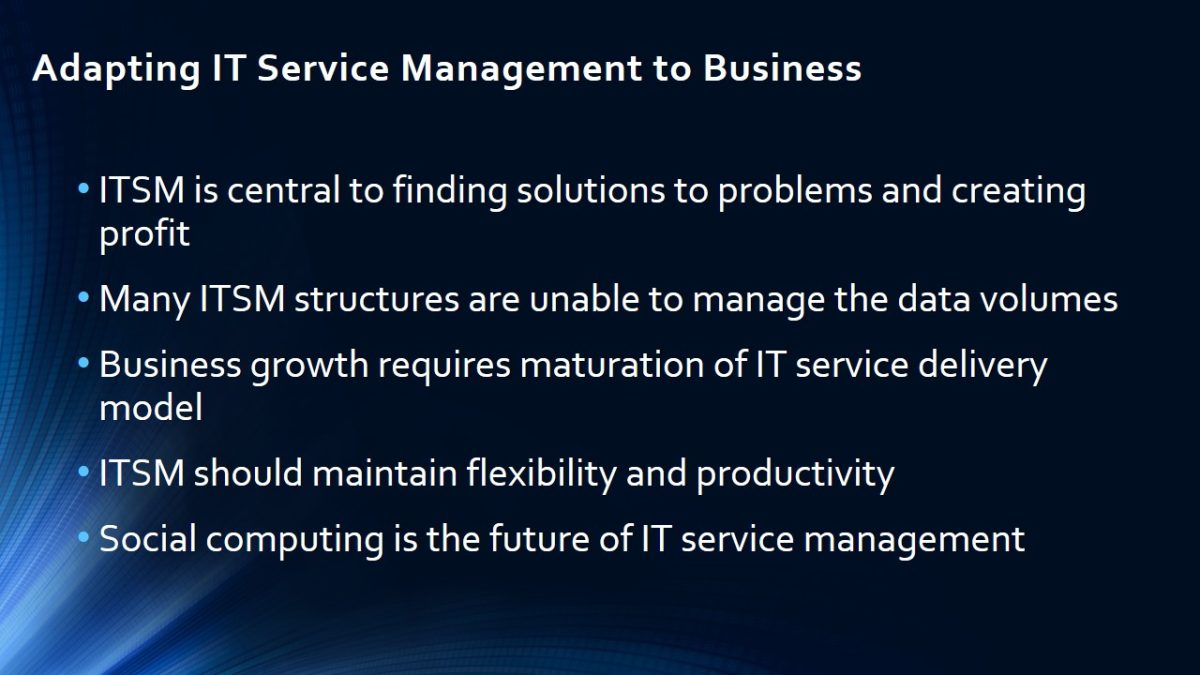
Customer Satisfaction through ITIL Service
- ITIL was not originally designed for customer service.
- IT services can be provided to customers as well as the company.
- The framework can help define performance indicators of customer service.
- Products and company services are better categorized.
- Helps to forecast customer needs and product demands.
- Recent use of ITIL has been aimed at focusing on the customer
- Creates a method of communication between business and IT aspects of the company
- Satisfaction is based on customer perception that is influenced by expectation
- ITIL can formulate service strategy focused on addressing these aspects
- Service design is then used to manage availability and capacity capabilities of the company
While service management is a central part of the ITIL framework, it does not have any direct applications to customer service improvement. Customer satisfaction is an incredibly vague and general aspect which does not adhere to logical structures of information technology. However, this emphasis on standardization offered by ITIL can have significant customer satisfaction implications. As part of ITIL implementation, consumers and stakeholders can be engaged in identifying the strategic direction of a company.
In the strategy stage of ITIL, a range of factors such as market trends, opportunities, and services are analyzed to form a strategic direction for a company based on set objectives. For companies such as Starbucks, customer satisfaction will remain a priority goal. Therefore, throughout all stages of the ITIL framework implementation, there is a focus on improving that performance indicator. Most attention to customer satisfaction is usually given during the continual improvement stage.
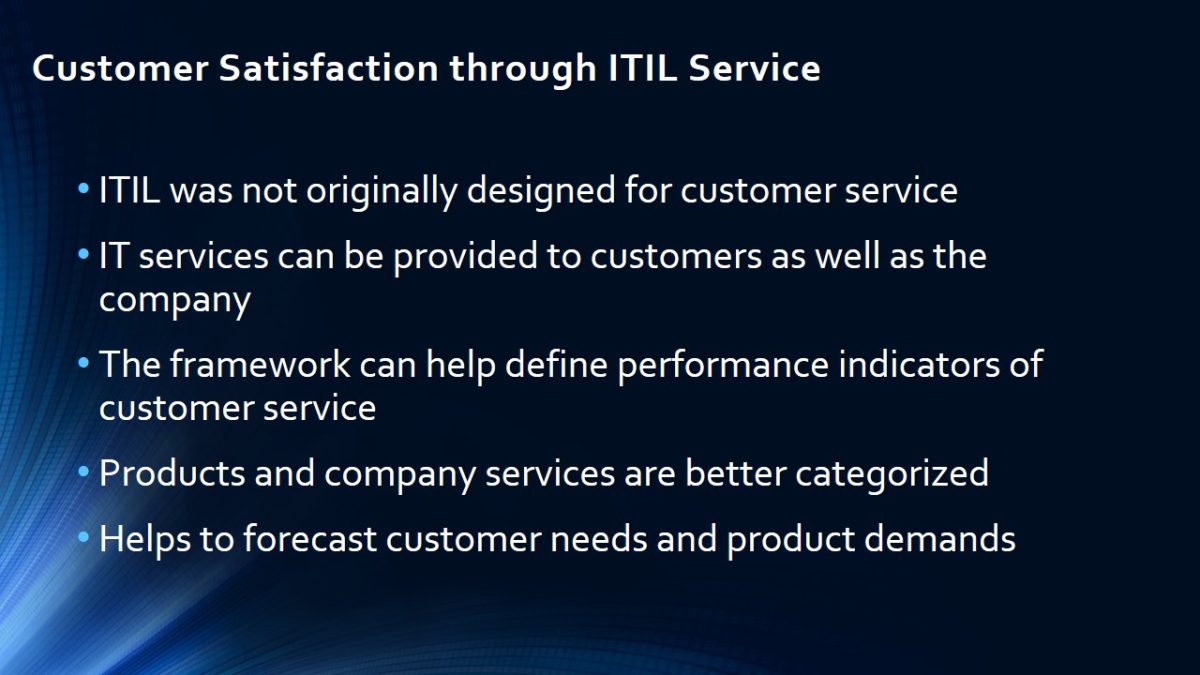
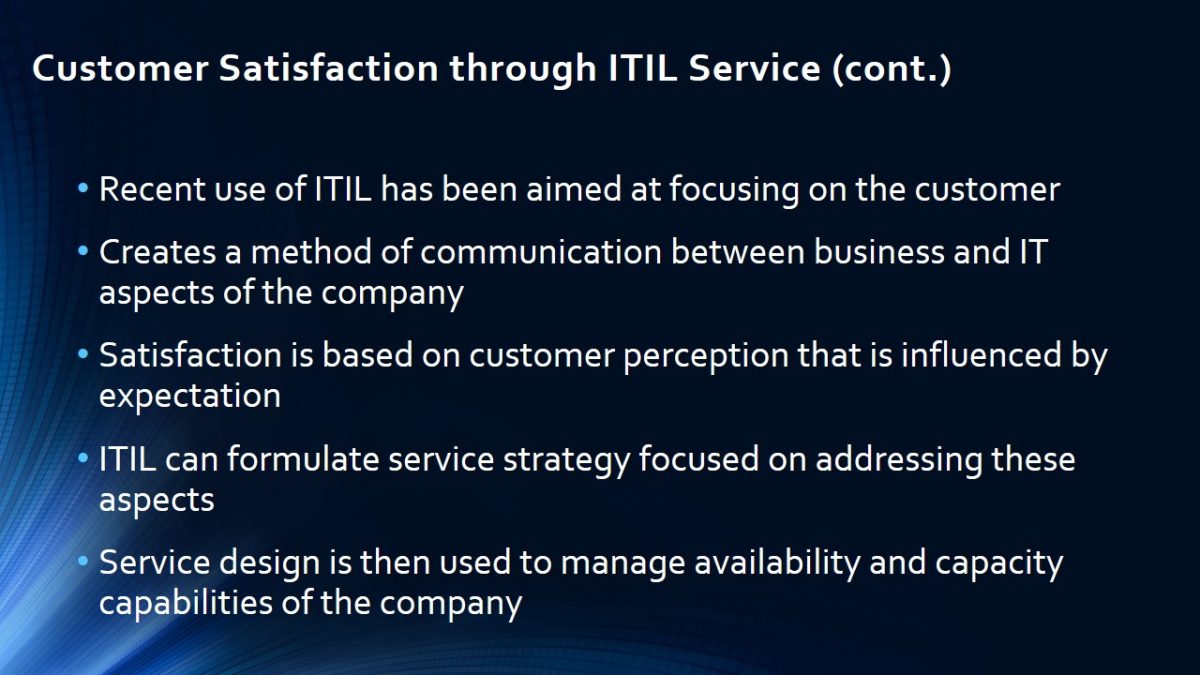
Evaluating Success of ITSM Tools
- Successful implementation is achieved with measurable goals.
- IT should select metrics to track based on value to the business.
- Identify key performance indicators which support those valuable IT objectives.
- Reporting results based on metrics.
- Utilize dynamic dashboards with real-time updates.
When a company first implements new ITSM tools, it has to set measurable objectives as a baseline. However, in order to achieve specific goals, it is important to know which metrics are conducive to its fulfillment. ITSM tools such as ITIL help to determine and select the various metrics to boost performance. However, each organization has inherently different strategies. Therefore, there are no defined metrics to measure. Each metric should be directly connected to business performance.
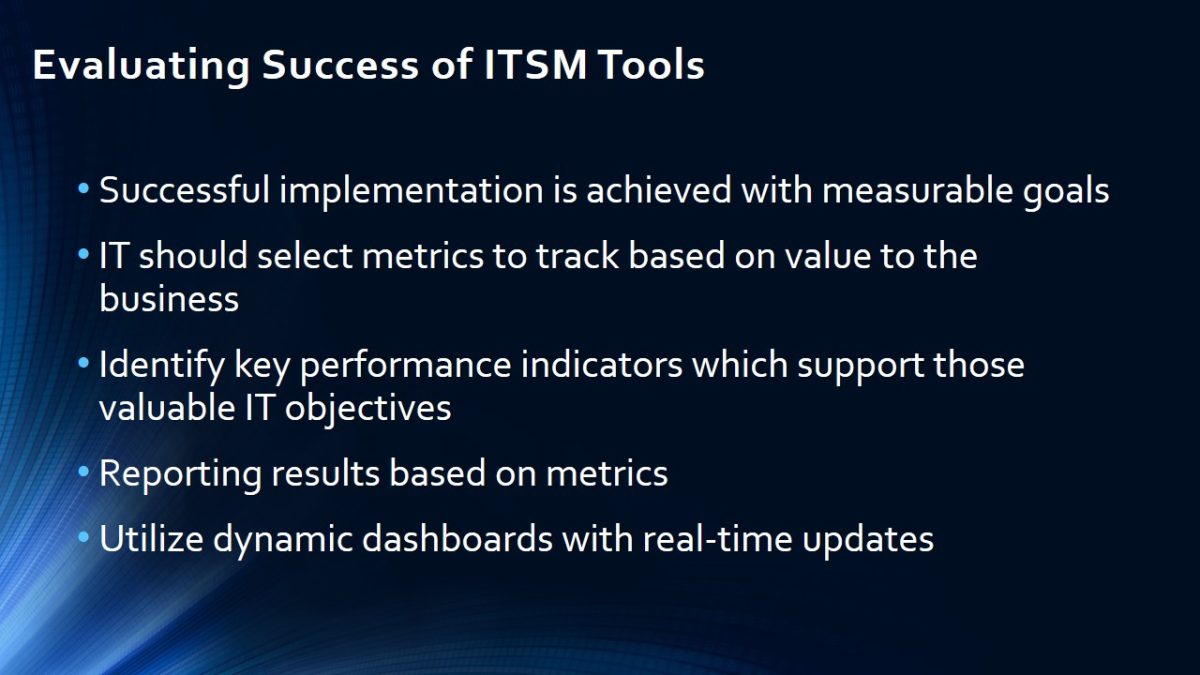
Solutions
- Starbucks began collaboration with IT and business management consulting firm Pink Elephant.
- ITIL framework was used to introduce a revamped training program.
- Employees had freedom for self-development based on existing training and knowledge.
- Staff were equipped with skills to work in the high stress and social environment.
- The training helped to increase productivity.
- IT services helped to develop a training budget and forecasted organizational parameters.
- Automation created transparency and conserved time.
- Operational optimization and production capabilities improved.
- Enhanced quality of products and services which led to customer satisfaction.
- Starbucks could identify key metrics to meet its objectives such as increased sales.
Due to the unskilled workforce that led to the production of low quantity and quality products, the company decided to find and hire other people who could provide the best training to the employees. Employees could freely grow and develop skills in their respective fields. Furthermore, employees developed improved communication and understanding with colleagues which increased productivity. Therefore, Starbucks addressed the critical issue in its organization by training the unskilled workforce.
The new training portal provided a clear insight regarding the training budget that helped in forecasting the reality of the organizational state. The automation and the transparency of the back office helped in conserving time and creating peace of mind to workers. Rules and steps are taken to implement governance of information technology that optimized optimizing various business processes and supply chain management. Key performance indicators such as first contact resolution could be tracked via ITSM tools to determine the connection to the fulfillment of its business strategy.
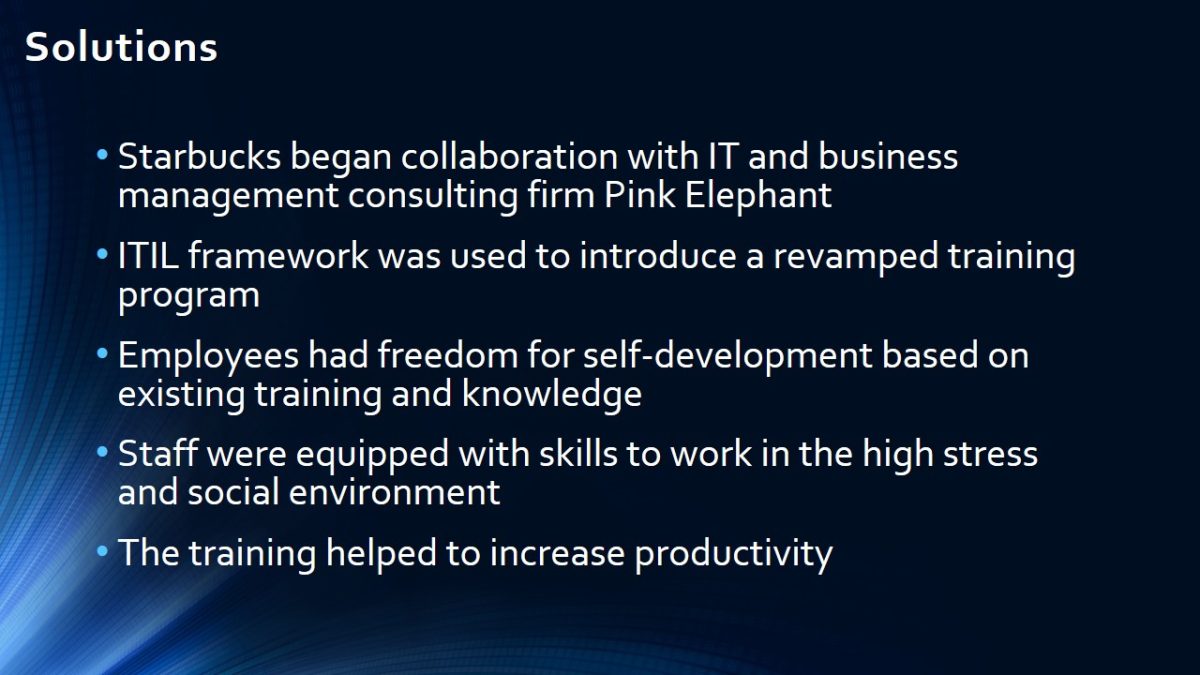
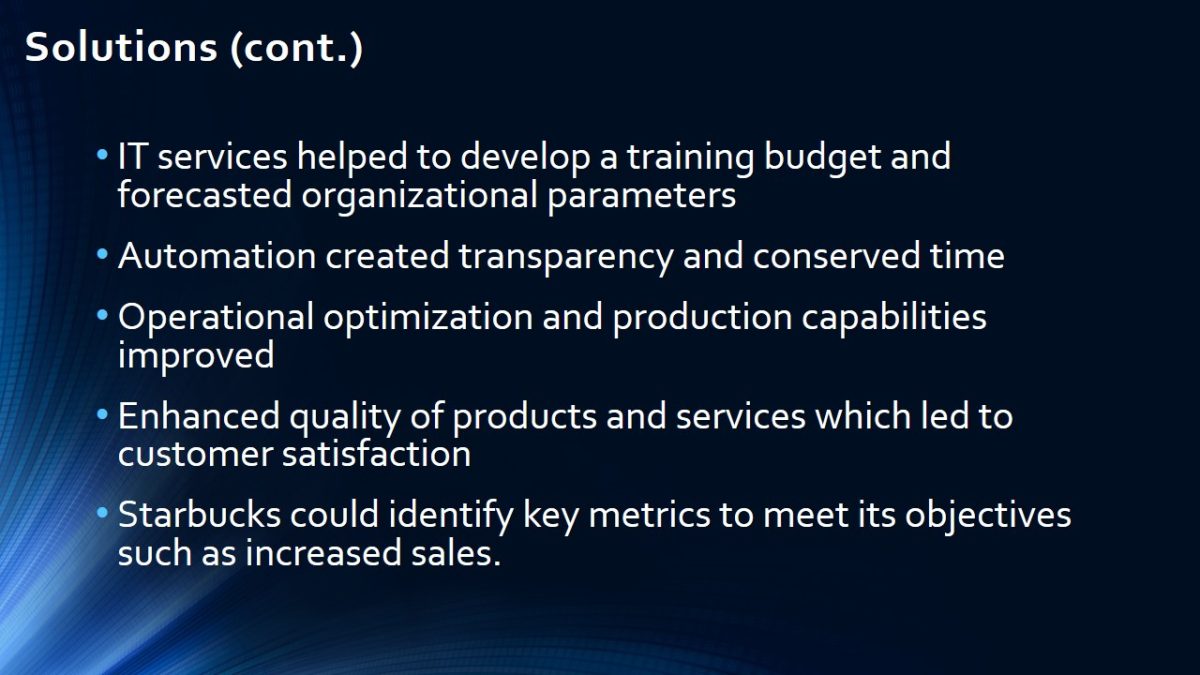
Summary of Results
- Training evidence shows production state of the company improved.
- Equipped the employees with knowledge and skills.
- Enhanced the quality and quantity of the product produced by the company.
- Equipped the employees with the understanding mind.
- ITIL helped the company to meet the set goals and the satisfaction of the customers.
To achieve the desired set goals, the organization has to follow a set of rules in implementing ITIL. The steps also help the organization to find a way of satisfying its customers. ITIL was able to achieve this for Starbucks by creating a universal and efficient training portal. The training plan was clear, high-quality, and brought together various segmented parts of the company. In turn, this resulted in an improved performance which helped achieve financial objectives and customer satisfaction ratings.
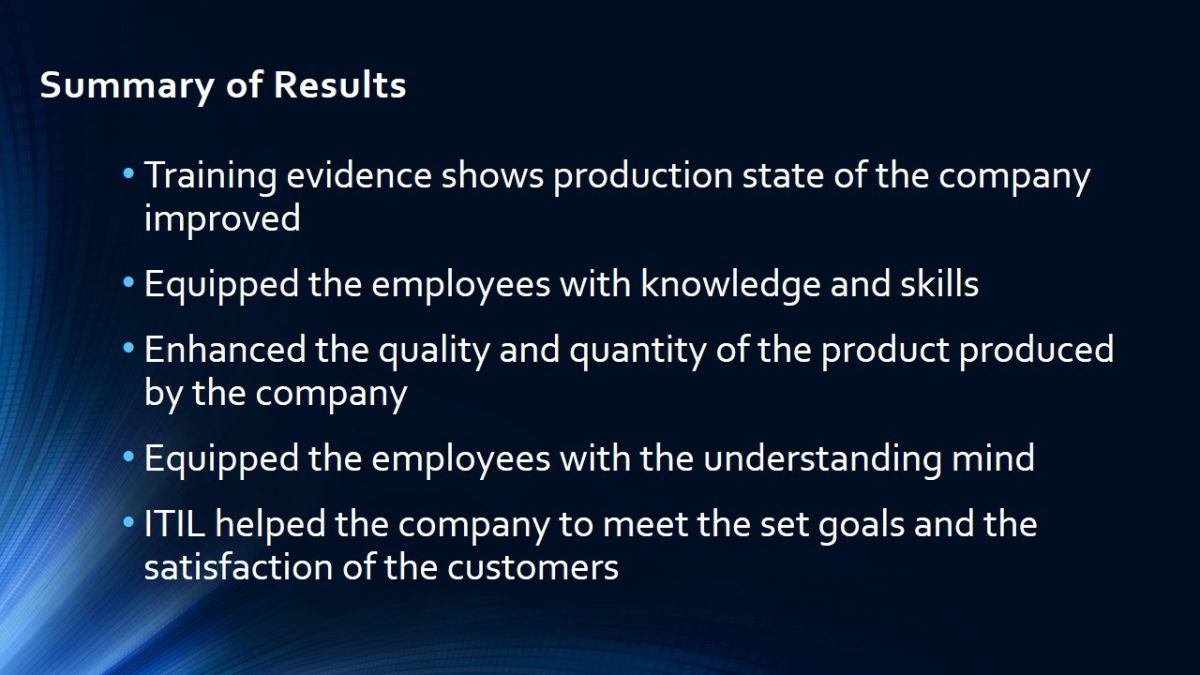
Conclusion
- Starbucks is a highly profitable and marketable corporation.
- Focused on increasing its growth and innovation.
- ITIL framework helped to benefit the chain by optimizing various business processes and supply chain management.
- Rules and steps are taken to implement governance of information technology.
- Through the use of IT service management, training was developed to address critical issues in the company workforce.
- Resulted in increased quality and productivity.
Providing the best quality of the products satisfy the consumers wants and helps the organization to achieve the desired goals. ITIL helps in diversifying the company thus creating a vast market for the goods produced. The organization can also derive and estimate the performance and the productivity of the business organization thus focusing on KPI which can increase growth and sales.
